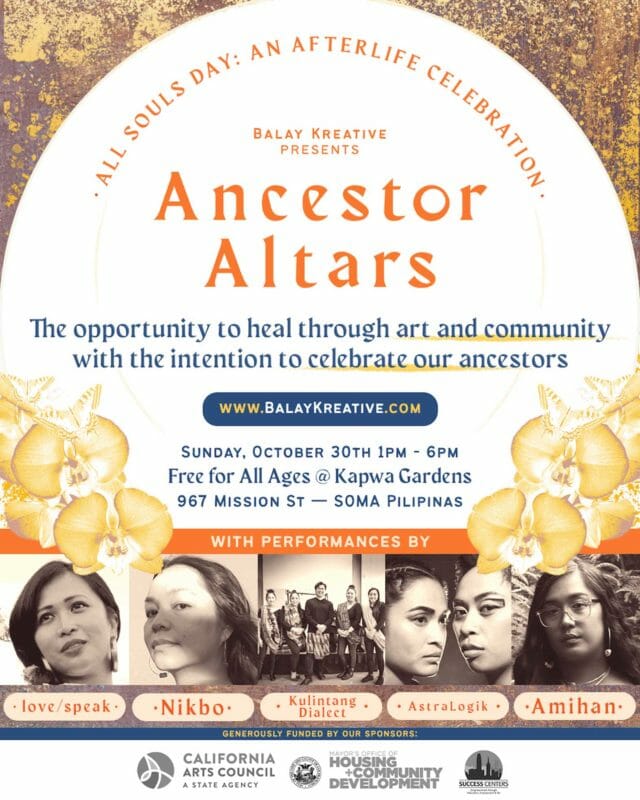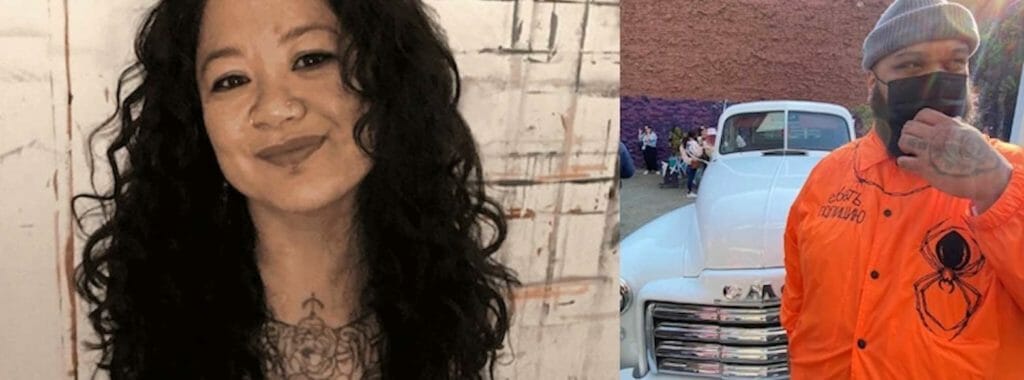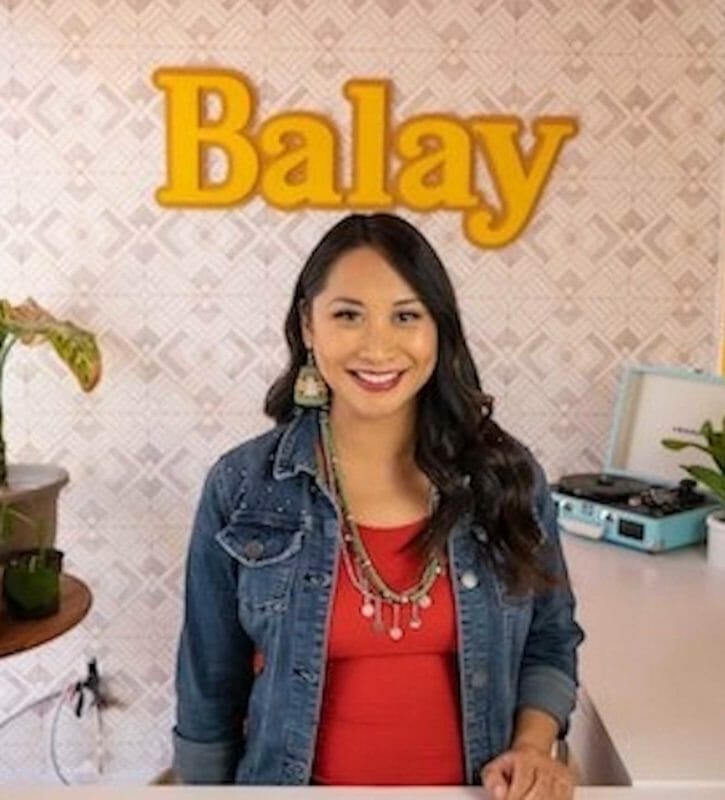‘Ancestor Altars’ art installation honors departed loved ones

Ancestor Altars, All Souls Day: An Afterlife Celebration poster CONTRIBUTED
SAN FRANCISCO – Ancestor Altars, an art installation, is on view from October 27 to 30 at Kapwa Gardens and a virtual gallery.
A collaboration between Kultivate Labs and Balay Kreative, Ancestor Altars is a collective work led by installation artist and painter TITTY with photos, names, and stories of loved ones who have passed away submitted by members of the Filipino community.
Artist Cece Carpio painted portraits of a selection of ancestors who have passed away in the last three years. These ancestors include Amado Khaya Canham Rodriguez, Marco Jastillana, Maria Elena Pastor, and Yolanda Lauron.
Carpenter Ciriaco Sayoc helped with the installation, and virtual architect Shania Louis Sagra Ambros designed the virtual gallery.
Inspired by Undas or All Souls Day in the Philippines, Ancestor Altars is the brainchild of Balay Kreative’s Program Manager Nicole Salaver in response to the COVID-19 pandemic.
“I personally lost three family members due to COVID. My family couldn’t meet for the funerals,” says Salaver. “I just know a lot of families that miss that aspect of community and healing, so I wanted to do something in honor of those who passed away due to the coronavirus. For Filipinos, gathering and having that physical connection is so healing for us.”
To mark the occasion, an All Souls Day, An Afterlife Celebration will be held at Kapwa Gardens on Sunday, October 30 from 1 p.m. to 6 p.m.
Free and open to all ages, the event will have food and drink vendors and feature live musical performances by Nikbo, Kulintang Dialect, AstraLogik, and Amihan. The event will be emceed by love/speak.

Cece Carpio (L) Ancestors Altars portraits artist. TITTY ® Ancestors Altars installation artist. CONTRIBUTED
“We also want to invite families who have lost someone during the pandemic to come up, celebrate, and speak about their loved ones,” says Salaver.
A workshop on how to create ancestor altars at home will also be held at the event. Also featured is Embedded Bricks, an art project by Balay Kreative resident artist Cristine Blanco that is “inspired by land, labor, and lineage. Working around themes of ritual, protection and care, each brick is made of clay harvested from the artist’s backyard in 2020.”
The community is invited to inscribe their intentions into a handmade brick that will then be fired and buried. “Participants are asked to respond to the question: What is it that you want protected?”
Salaver emphasizes that the event will be a celebration rather than a somber occasion.
“In the Philippines, you have people drinking, playing music, and doing karaoke at the cemetery. So it’s much more a joyful and jovial event. It’s like you’re really celebrating with ancestors.”
She adds that there will be a space in front of the Ancestor Altars installation where people can place their offerings.

Nicole Salaver, program manager of Balay Kreative. CONTRIBUTED
“We will have spaces for people to add pictures or flowers. We will actually have flowers there, marigolds. People can place a marigold onto the altar space. People can add offerings, their family members’ favorite bottle of rum.”For her ancestor portraits, Cece Carpio created “light boxes,” not only to serve as frames but also as a metaphor for the path and journey of souls to the spirit world guided by light.
“It’s actually a very exciting part because it’s also fairly new to me,” says Carpio. “I created frames within frames to hold the light box and the lights in. Then I created designs against plexiglass so that the light will shine through. It was a learning process.”
Carpio remembers her childhood in the Philippines where the spirits and souls of the dead are a part of everyday life.
“I grew up in a small farming village where ghosts and spirits were not just mythology and legends.
She shares that she sometimes found her great-grandmother in the living room talking to someone that she could not physically see.
“Folks talked to spirits and saw spirits and all of those things. It was just part of how we lived. Our ancestors are very much part of this physical realm.”
Carpio recalls celebrating All Souls Day and going to the cemetery with her family to visit their loved one’s graves.
“We were kids playing with candles, making balls [with wax] while the adults brought food to offer. In my understanding during the time, it was just like our way, on our side, to help their [the souls of our loved one’s] journey.”
When Carpio and her family moved to the United States, celebrating All Souls Day was never the same away from the motherland.
“It changed in a lot of different ways. We didn’t have a cemetery to go to. My ancestors are not buried in this land.”
Carpio and her family lived in the Mission District when they came to San Francisco. It was where she first witnessed the Mexican tradition and celebration of Día de los Muertos. It made her see the similarities to All Souls Day and made her better understand her own tradition and practice.
What Carpio saw was the religious syncretism inherent in both cultures and traditions under the same colonizer. Spain’s imposition of Catholicism on the indigenous population of the Philippines and Mexico became infused with indigenous spirituality and practices.
The result is a culturally vibrant form of subversion that allowed the people to continue to practice their indigenous spirituality and traditions without persecution.
“I remember going to a village Catholic Church and they would still be killing chickens on the side or there’d be herbs being sold outside.”
Carpio’s creative approach to Ancestor Altars is “highly influenced” by her experience with Día de los Muertos as it relates to indigenous Philippine tradition and ritual.
Ancestor Altars is the first community-based project that TITTY has worked on. Prior to this, he has done art mainly as a painter and graphic designer.
“It’s a good feeling when I’m doing this. You feel like you’re healing with the community through all the darkness of the past three years.”
Collaborating on an art installation with the community for the first time did prove to be a challenge, from figuring the best way to collaborate with the community to being open to input and additions to the artwork from the community. It was a learning process on creating community-based art, a process intrinsic in indigenous ritual.
“At first it was challenging because I’m just not used to having any installations touched. It was just getting into the mode of being selfless with this project. I learned to be a little more selfless when creating. Instead of it being my installation, it’s the community’s installation,” says TITTY.
Born and raised in San Francisco, TITTY took inspiration for creating Ancestor Altars from his visits to cemeteries in the Philippines. He wanted to incorporate the “unique look and aesthetic” and lend a sense of authenticity to how All Souls Days is celebrated.
“I wanted to incorporate the classic Undas look with the glowy candles and stacked [tombs].”
He also took inspiration from Día de los Muertos as well as the urban environment he lives in by “taking a traditional aesthetic” and mixing it with his own.
“A lot of inspiration comes from the community, the hood. When someone gets shot or struck by a car, there are these light poles and they’d just be surrounded with candles and bears and pictures. I took a lot of that imagery and added that to the altar as well. Something very Undas but very San Francisco.”
Salaver’s vision for Ancestor Altars goes beyond the installation to where the community can do a version of it in their own homes.
“I would love it if we can continue to do this annually. A lot of my Filipino American friends have created their own ancestor altars within their home, outside of All Souls Day.”
She sees that Ancestor Altars can be a Filipino American tradition that connects us to our ancestors while recognizing and respecting its indigenous roots.
“As Filipino Americans, we now get to understand and have the capacity to do this tradition in our way. What’s great about it is that we are now re-indigenizing ourselves and decolonizing ourselves,” says Salaver. “What’s important about this event and the ancestor altars is honoring all that came before you in order to make you who you are today.”

